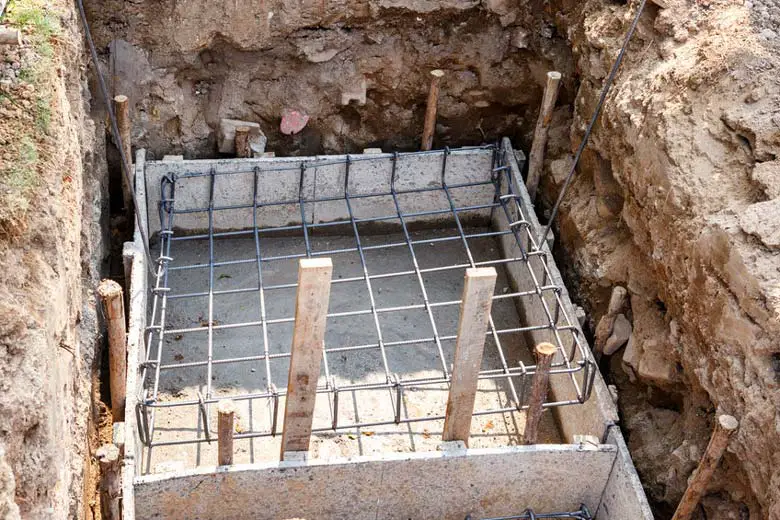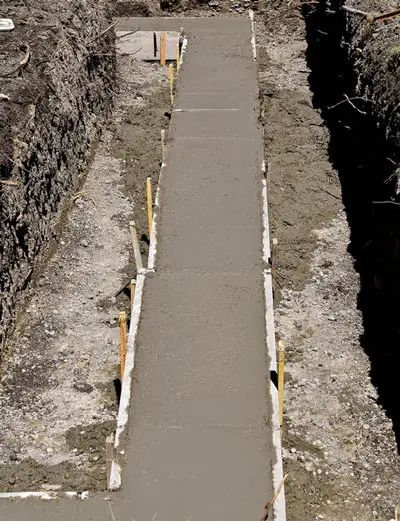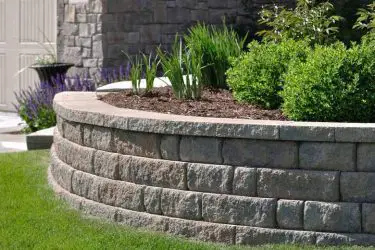Giving a concrete pour enough time to dry is essential in ensuring a smooth, aesthetically pleasing end result. However, figuring out how long your project needs to fully dry can often be challenging. Depending on many environmental factors and the cement blend you’ve used, the timeframe can widely vary.
Concrete footings take at least two days to dry fully. Depending on humidity levels and weather conditions, it could take up to a week or two for concrete footings to dry. However, the material goes through various stages of dryness, and it could be safe to touch much sooner.
In the following sections, I’ll take you through how to determine the necessary time for concrete footings to fully dry, how long they need to be cured, and why making the extra effort and taking the time to cure the material is often worth it.

Table of Contents
Factors Affecting Dry Time for Concrete Footings
Picking a single time frame when it comes to the necessary time for concrete footings to dry isn’t as easy as you might think. The material is highly susceptible to environmental factors such as weather conditions, so no two pours will be the same.
Additionally, the cement blend you’ll use, and its consistency can also affect how quickly the material dries out. Remember that the drying process revolves around giving concrete enough time to lose its excess moisture and achieve its ideal form. Therefore, the existing water content within the material will inevitably affect the time necessary for this to happen.
It’s especially important to give this process enough time when it comes to such a crucial component of your build’s stability and durability, such as the footings. Therefore, throughout their construction, it’s essential to exercise patience.
Concrete is a material that goes through several drying phases, which makes singling out a “drying” time frame even harder. I put “drying” in quotes because the word takes several meanings throughout the span of a month (which is the time necessary for concrete footings to fully cure).
For example, you may already know that there’s a difference between a concrete pour that’s dry enough to touch, one that’s dry enough to walk on, and another that you’re able to drive on. Additionally, you may have to wait an additional two or three weeks after that for the material to be cured entirely
Concrete Footings Drying Phases
Here’s how I would differentiate between concrete’s levels of dryness (in footings):
- Safe to touch – The material will likely be safe to lightly touch within a few hours of being poured. Again, the timeframe will vary depending on humidity levels, but generally speaking, as soon as concrete turns matte and dry in appearance, it’ll be safe to touch (carefully).
- Safe to apply pressure – After a day or two, concrete will have gone through its initial set, at the end of which it’ll have significantly hardened. At the end of the 24-hour mark, you may start considering whether your footings are sturdy enough for you to put a more extensive amount of force on them. However, I’d recommend waiting at least 48 hours for good measure (sometimes more if you’re constructing your build during winter).
- Safe to apply extensive pressure – You’ll have to wait at least a week before starting to build upon your concrete footings. By this time, the material will have solidified enough to withstand a substantial amount of pressure. However, the curing process will only be partially finished.
- Fully cured concrete – Concrete takes at least a full month to fully cure. Although it’s possible to successfully use the material without having to wait this long for it to cure, the process carries a wide range of advantages you won’t want to miss out more. (I’ll take you through each of them in the “Why Do You Need To Cure Concrete” section of this article.)
In short, although it’s possible to put down the first brick layer within 24 hours from the initial pour, exercising patience and leaving your concrete time to fully dry may pay off in the long run.
Additionally, if you’re working in a colder, more humid environment, keep in mind to take this factor into account when calculating the necessary time for your footings to dry.
Keep in mind, these phases are just a guideline of what to expect under normal working conditions. If you’re pouring your footings during winter, the wait times may sometimes be five times longer than those I’ve mentioned.
How Long Do Concrete Footings Take To Cure?
Curing is a concrete drying approach that protects the material from excessive moisture loss, increasing its durability and sturdiness while preventing cracks or openings from appearing on its surface.
Concrete footings can take anywhere from a week to a month to fully cure. Ultimately, the total dry time depends on the materials used, temperature levels, and humidity. Notably, it may take even longer for the footings to fully cure during winter.
Additionally, wait times can vary even more depending on whether you’re using a quick setting additive or not. This goes to show that you can easily manipulate the timeframe necessary through the cement mix you use and the conditions you choose to work in.

By providing the material with the necessary time to safely dry without losing too much moisture, it’ll be much more likely to achieve your desired texture, strength, and overall look.
The curing process requires you to always maintain high humidity levels within the material (above 80%) and keep the temperature above 50°F (10°C).
By doing so, you’re preventing excess moisture loss and allowing the material to dry out more safely throughout a more extended period of time.
Luckily, you won’t always need to wait a full month for your concrete footings to cure. In some cases, when you’re working during hot summer months, you’ll only have to let the material cure for a week before it achieves its optimal texture and strength.
Be sure to frequently check the material by measuring its moisture levels to determine whether it has been fully cured or not. Following an arbitrary time frame that’s not tailored to your specific working condition can never give you the optimal results you’re looking for.
If you want to learn more about how you can optimally cure your concrete footings, here’s a handy guide that goes over all the possible approaches you can follow.
Why You Need To Cure Concrete Footings
If the concrete footings are able to handle excessive amounts of pressure within a week of their pour, why would you need to leave them an entire month before continuing on with the building process? Well, I’m here to tell you that curing your concrete is crucial in ensuring your footings are as durable as stable and possible, and there are a few reasons for this.
First of all, the process allows the material to still retain its moisture even though it hardens, preventing it from getting too dry and fragile, which could be detrimental to a building’s structural integrity.
Secondly, by allowing concrete to hold onto some much-needed moisture, the material becomes stronger and more flexible, preventing any imperfections or cracks from forming on its surface. The reason why these imperfections are prone to happen is concrete shrinkage, which often occurs as a result of a quick drying process. However, by maintaining water retention and making said process more gradual, curing helps avoid this issue altogether.
Overall, curing your concrete footings will significantly improve their quality, durability, and strength, giving you absolute peace of mind when it comes to the safety and longevity of your build.
Conclusion
The time necessary for concrete footings to fully dry can widely vary depending on materials used, environmental conditions, and the drying approach you choose. Generally speaking, concrete needs around a day or two before it can be safely handled, a week or two before it can be built on, and up to a month before it’s completely cured.



